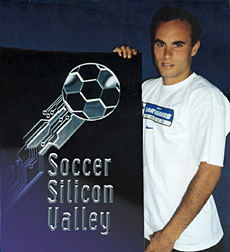 |
 |
||||||
Silicon Valley and the Bay Area are known worldwide as places of visionary entrepreneurs who have one eye on the present and one eye on the future, recognizing that the path that lies between the two is one of opportunity. The ability to recognize this path sooner than anyone else has shown itself time and again to be a key to success. At Soccer Silicon Valley, we see soccer in much the same way that a venture capitalist might see an emerging technology. By examining the past and evaluating the present, it's possible to see soccer's potential, both in its value to a community and as an investment. Pundits will note that soccer has been touted as "the sport of the future" in the U.S. for nearly 30 years, ever since Pelé signed with the New York Cosmos in 1975. Similarly, they will point to the demise of the North American Soccer League as a sign that Major League Soccer will also fail.
What the pundits don't know about is soccer's incremental growth over those 30 years. The children who grew up watching the NASL went on to become the players that took the United States to the World Cup in 1990 as our country made our first appearance in the tournament in 40 years. Our success then helped the U.S. win the right to host the 1994 World Cup, the most successful tournament in the competition's history. The stars from the 1994 team, men like Eric Wynalda and Alexi Lalas, became the foundation for Major League Soccer (MLS), which held its inaugural game in San Jose in 1996. Soccer's continuing trend of growth in America has been greatly enhanced by MLS. Bruce Arena coached DC United to championships in the league's first two seasons and was hired to coach the U.S. National Team after the 1998 World Cup. His first game as the U.S. boss was held in San Jose in November, 1998, and he has gone on to become the most successful coach in American history, leading the team to a third place finish in the 1999 Confederations Cup and a quarterfinal finish in the 2002 World Cup. The 2002 World Cup also served notice that players from MLS could compete on the biggest stage, as MLS stars like the Earthquakes' Landon Donovan showed their class. Soccer's growth has been reflected off the field as well. 1999 saw the opening of Columbus Crew Stadium, the first soccer-specific stadium in the country. That was followed by the Home Depot Center in Carson, Calif., a $150 million complex which includes a training center for U.S. Soccer as well as facilities for tennis, track and field, cycling, volleyball, baseball, softball, basketball, and other sports. Stadiums are also either approved or under construction in Chicago, Dallas, and Harrison, NJ, and noted stadium architects HOK — designers of SBC Park in San Francisco — are working on plans for a newly-announced stadium in Denver. The sport continues to be incredibly popular among participants as well. A study conducted in 2000 by the Soccer Industry Council of America (SICA), a committee of the Sporting Goods Manufacturers Association, showed 18,176,000 participants nationwide, a higher number than football, baseball, softball, or hockey. The SICA report showed California with 2,154,000 players, the highest total in the nation. The number of young adults playing high school soccer increased almost 73 percent from 1989 to 1999, from 321,964 to 556,171, a trend that has continued in the new century as shown in a 2003 study by the National Federation of State High School Associations which recorded 646,606 students playing high school soccer nationwide. If you're interested in more information about the sport's present and future, we invite you to explore this Preliminary Market Analysis and Facility Review presented by Craig Skiem of Convention, Sports, & Leisure International (CS&L) to the San Jose Sports Facility Task Force. (Adobe Acrobat required.) It covers topics such as MLS fan demographics, San Jose market information, an MLS attendance analysis, and information about MLS facilities development. The data is clear. The sustained incremental growth of the sport over the last three decades has established a solid foundation on which to build. At Soccer Silicon Valley, we believe that an investment in soccer is a wise one.
|
||||||
